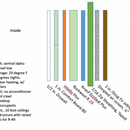Thoughts on my wall detail?
Hi – We’re building in zone 6b, US. We are looking at creating the following wall assembly, given that we didn’t plan for exterior insulation to begin with. (too late to add it now, windows and doors are in).
The only thing that we’re unsure about is the vapor retarder. Do we need to go as far as using intello, or, can we simply use primer and latex paint on the drywall to provide enough retardation of the vapor? Even in winter, its a dry climate, but with all of the air sealing it will be tighter than most homes, though we should be able to balance everything with the ERV. I’m thinking that the intello may be overkill, but looking for some insight here. Thanks!
GBA Detail Library
A collection of one thousand construction details organized by climate and house part










Replies
The IRC requires a class 1 or class 2 interior vapor retarder in climate zone 6 unless you have enough exterior insulation to provide dewpoint control. Even if you don't have to follow codes, they are a good baseline for minimally-acceptable building practices. In other words, use a membrane. Intello is ideal but you would probably be ok with less-expensive Certainteed Membrain, though I prefer the lower perm rating and more durable Intello (or Siga, or Rothoblaas versions) when possible.
Thank you Michael.
Comfort board is too squishy to install drywall directly over it. I would change that to foil faced polyiso with taped seams. This iso can now work both as your warm side air barrier and vapor barrier required by most codes. With interior iso, make sure the electricians install the device boxes offset out enough to reach the drywall.
The ECOseal and ZIP seems redundant, I would pick one or the other.
I'm not sure which dimpled air screen are you looking at, just make sure it is permeable product, some are true vapor barrier and should not be used directly over sheathing in cold climate. Strips of 3/8 plywood or 1x4 strapping tends to be much simpler to install than drainable matts.
I would run through your energy analysis to figure out your yearly heating costs. 4000sqft in your climate will be pretty expensive to heat with electric resistance. If you want to keep the floor heat, I would include a heat pump to provide some (even a good portion) of your space heat needs.
Thanks for your thoughts Akos.
I would try to move that comfort board to the exterior, outside the sheathing. I prefer my continuous insulation to be on the exterior, which keeps the sheathing a little warmer, so it's a little safer, in my view. I would use the interior side vapor retarder regardless, for extra insurance, but I'd save some money and go with MemBrain. You could use the polyiso on the interior side as Akos mentioned, even if you use comfort board on the exterior, but you could save money by using ALL polyiso (no comfortboard), and putting it on the exterior.
Note that if you use taped polyiso on the interior, it's very important to seal any services (electrical boxes, etc.) to maintain the integrity of the polyiso if that's your air barrier. Putty pads may be the best way to do that here. You can get very deep mud rings to bring the devices up flush with the finished drywall even if you have 1" polyiso. You can get mudrings up to around 1-1/2" depth, maybe deeper -- although I don't like working with them because they make it harder to reach back into the box. Use 4" square boxes if you go this route so that you have a good selection of mudrings. If you go with exterior continuous insulation, then I'd use the white fiberglass "hard boxes" on the interior in the normal residential installation way, since those boxes don't have lots of extra holes which makes them easier to air seal.
Bill
Thanks Bill, will definitely look up those hard boxes.
Tell us about the Knauf ECOSEAL Plus.
Is this a continuous layer?
Is the outer surface of the Zip you air barrier?
If so why not select a Zip branded sealer?
I like the idea of moving the continuous insulation to the exterior.
Is the extra cost of the rockwool a good investment give that damp sprayed cellulose will fill the voids better with less labor using lower cost and greener materials?
Walta
Hi Walta - Ecoseal is a liquid, spray applied, sealant. We plan to use it at the top and bottom plates for sealing, around penetrations, and between the stud bays at the stud/sheathing intersections. I'm not familiar with damp sprayed cellulose, mainly dense packed cellulose is used in this area. Thanks for your comment.
Seems to you should pick one location for an air barrier. The idea with the Zip system is to connect the green face to the foundation moving the bottom plate inside the air barrier so there is no fussy sealing needed. The connection between the sheeting and the drywall ceiling is generally not a big leaker.
The damp sprayed cellulose is sprayed in place with water-based adhesive overfilling the bays. The bays get scraped flush with a power tool. You get a 100% fill that does not settle. The over fill is feed back into the sprayer so almost no waste.
Walta